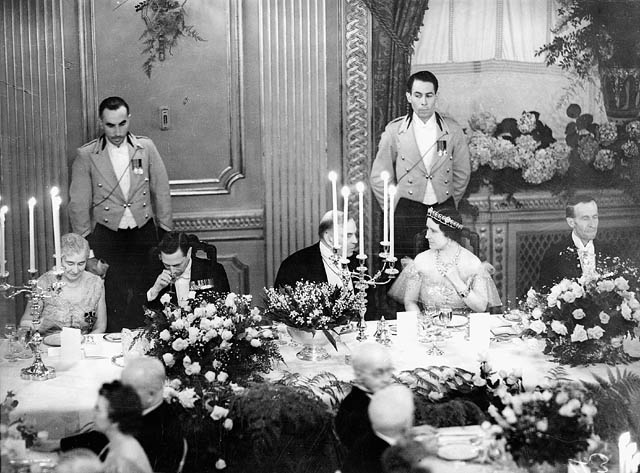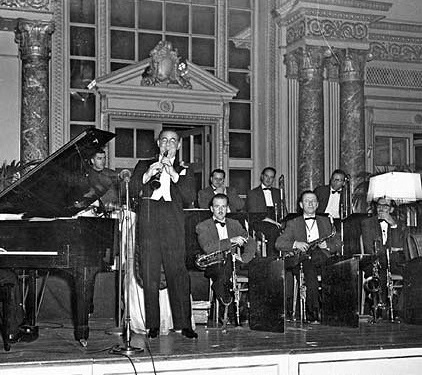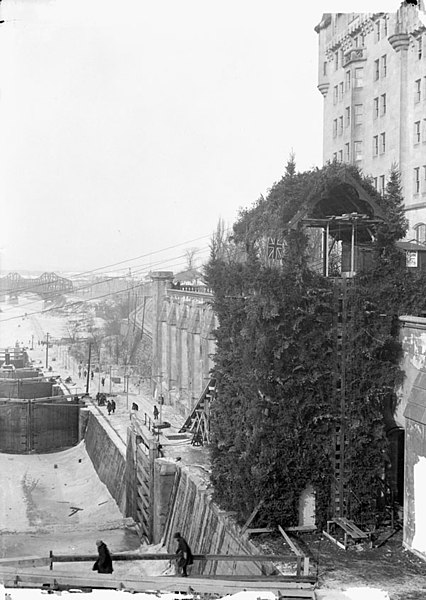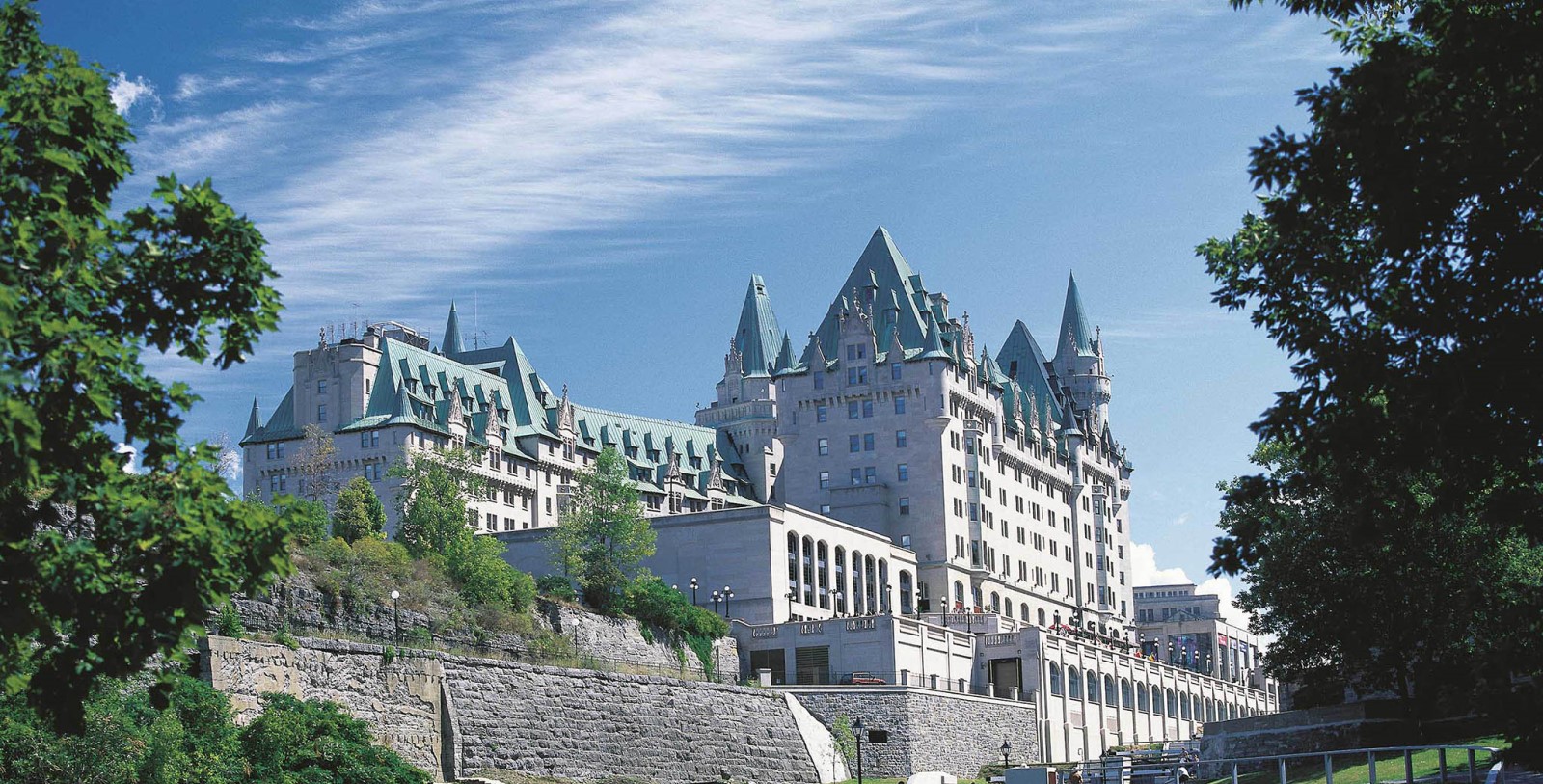history
Discover the Fairmont Château Laurier, which was once the one of the leading hotels for the historic Grand Trunk Pacific Railway.
Fairmont Château Laurier, a Member of Historic Hotels Worldwide since 2017, dates back to 1912.
VIEW TIMELINELed by the ambitious American railroad magnate Charles Melville Hays, the Grand Trunk Railway flourished throughout western Canada in the late nineteenth century. Hays envisioned a new system that extended all the way to British Columbia, in which new, company-owned tourist destinations along the line incentivized more customers to use the route. As such, the Gran Truck Railway constructed several deluxe hotels in the major cities where the new railroad appeared. When the railroad finally arrived in Ottawa, Hays hired the Canadian architectural firm, Ross and MacFarlane, to build what would become the Château Laurier. The architects designed the building with French Renaissance style architecture, while also including a bit of Gothic Revival-style flair. Hays spared no expense on the project, allowing for Ross and MacFarlane to utilize fantastic building materials, such as Italian marble, light-buff Indiana limestone, and copper. Inside, the hotel’s guestrooms featured luxurious amenities for the time, including access to indoor plumbing, laundry services, and automobile repair shops. Antique furniture, Czech crystal vases, and a fabulous grand staircase defined the Château Laurier’s front lobby, as well. In the end, Hays and the Grand Trunk Railway spend over C$2 million on the construction, which roughly translates to $50 million in today’s currency.
Charles Melville Hays eventually chose Canada’s seventh prime minister, Sir Wilfrid Laurier, as the namesake for the location. He had originally intended to debut the Château Laurier before the City of Ottawa in April 1912. Yet, Hays’s death onboard the RMS Titanic caused his colleagues at the Grand Trunk Railway to postpone the opening for several months. It would not be until June that the hotel finally opened. Nevertheless, the Château Laurier opened to glowing praise throughout the city. Sir Laurier presided over the ceremony and was the first guest to sign the hotel’s register. Within a matter of years, the building became one of the most sought-after hotels in Canada. Its burgeoning popularity even inspired the Canadian National Railway—which had absorbed the Grand Trunk Railway—to greatly expand the building. It specifically added 240 additional guestrooms onto the hotel in 1929, as well as a brilliant Art Deco pool a year later. As the first and only luxury hotel in the area, the regal Fairmont Château Laurier changed the face of Ottawa’s downtown scene by adding elegance and sophistication to the city.
Since its opening day, this luxury hotel in Ottawa has hosted prominent politicians and royalty. In fact, several political deals, careers, and governments have been created within the hallowed walls of Fairmont Château Laurier. Canadian Prime Ministers Richard Bedford Bennet and Pierre Trudeau have called the hotel home. Other dignitaries like, Queen Elizabeth II, Winston Churchill, King George IV, Nelson Mandela, and former U.S. President Herbert Hoover have all signed the hotel registry, as well. Yousef Karsh, a world-renowned portrait photographer, operated his studio from the sixth floor from 1970-1992, too. He photographed many international celebrities from this space, of which 15 of these pictures have been gifted to Fairmont Château Laurier. Illustrious international celebrities like Shirley Temple, Harry Belafonte, Roger Moore, and Smokey Robinsons have all resided at the Château Laurier. To commemorate this stunning past, the Minister of the Environment designated the Fairmont Château Laurier a National Historic Site of Canada. Fairmont Château Laurier also joined Historic Hotels Worldwide in 2017. With so much history encased in its glorious walls, the Fairmont Château Laurier occupies a vital place in Ottawa’s history.
-
About the Location +
Fairmont Château Laurier is located on prime real estate in downtown Ottawa that overlooks much of the surrounding landscape. The city itself was originally founded as a campsite by British Royal Engineers who were tasked with constructing the historic Rideau Canal in the 1820s. Led by Lieutenant-Colonel John By, the engineers set about cutting a 126-mile-long canal that could act as an alternative shipping route for commerce traveling down the Ottawa River to reach the mighty St. Lawrence. Lieutenant Colonel By eventually transformed his outpost into a town for his soldiers and their families, which quickly became known as “Bytown.” The community rapidly grew, as all kinds of contractors, merchants, and tradesmen flocked to the area to help build the Rideau Canal. At the same time, a vibrant lumber industry emerged around Bytown that provided timber for the British and American markets. Countless lumber mills soon populated the region, making it the dominant local economic force by the mid-19th century. Bytown’s population had grown so significantly that regional officials incorporated it as the “City of Ottawa” in 1855.
The Rideau Canal had played a major part in transporting massive quantities of wood to Western markets int eh early 1800s. Yet, its role was gradually diminished by the steam locomotive, which had become a common sight in Ottawa by the 1860s. The Grand Trunk Railway was the first Canadian company to link the city with a national railroad network, further connecting the city’s prosperous lumber industry to the world. But the railroads also placed Ottawa centrally in the Province of Canada, which Queen Victoria of the United Kingdom had formed from the colonies of Upper and Lower Canada (now modern-day Québec and Ontario, respectively). After much political debate, the queen decreed in 1857 that the city would serve as the capital for the new province given its newfound geographic relevance. The city was then selected to become the capital for the entire Dominion of Canada a decade later, when the provinces of Canada, New Brunswick, and Nova Scotia consented to unify as one federated political entity. The population of Ottawa subsequently tripled decades following these political developments, reaching a height of 21,545 by 1871. Most of the city’s iconic municipal buildings also emerged within this timeframe, with Parliament Hill developed between 1859 and 1866.
Lumber began to decline significantly as a prosperous business at the start of the 20th century, although it was quickly replaced by several new industries. Most of those economic endeavors relied upon the newly recognized hydroelectric potential of the nearby rivers, with pulp and paper factories becoming the most dominant. A lucrative research community also appeared around this time, too, led by the National Research Council and the Defence Research Board. Dozens of companies specializing in technological innovation later spawned from that environment, such as Leigh Instruments, Nortel, the JDS Uniphase Corporation. The sector had benefited from the maturation of the national Canadian government, which had greatly subsidized much of its research. This growth began in earnest during the 1940s with the outbreak of World War II. The extraordinary scale of the conflict prompted the federal bureaucracy to expand exponentially to prosecute the war effort. As such, the Canadian national government was one of the largest employers in Ottawa—a trend that continues well into the 21st century.
-
About the Architecture +
President of the Grand Trunk Railway, Charles Melville Hays, commissioned the Château Laurier to act as the shining gem in his company’s portfolio of luxurious holiday destinations. He specifically hoped that the hotel would encourage travel to Ottawa on his new railway passenger cars, thus elevating the Grand Trunk Railway way above its competitors. Hays had many powerful allies that shared his ambition, including officials within the national Canadian government. The Prime Minister of Canada at the time, Sir Wilfrid Laurier, even gave his support, as he secured the site of the hotel’s construction atop what was then known as “Major’s Hill Park.” Furthermore, Laurier’s government started subsidizing the Grand Trunk Railway, in part, to help expedite the building’s development. Yet, the project proved to be anything but easy. Hays and his allies had to constantly fend off attacks from concerned locals who were aghast that the popular Major’s Hill Park would be lost in favor of the Château Laurier. They also had to fire their originally architect, Bradford Gilbert, over tense disagreements regarding the hotel’s layout. The group had to scramble to find an adequate replacement in a matter of months, eventually reaching an agreement with a Montréal-based architectural firm called Ross and MacFarlane.
Nevertheless, construction commenced on the Château Laurier in 1909 and lasted for nearly four years. Taking some C$2 million to complete, work on the hotel coincided with the creation of the neighboring Union Station. For the building’s exterior, Ross and MacFarlane relied heavily upon Châteauesque-style architecture alongside some Gothic Revival-themed flair. Châteauesque-style architecture borrowed design principles from the grand Renaissance-era manors that populated France’s famed Loire Valley. As such, the hotel featured conical turrets, dormer windows, and a spectacular pitched copper roof. Most of the structure’s gables displayed ornate carvings that depicted various kinds of flowers, scrolls, and crests. Ross and MacFarlane also filled the frame with some beautiful Indiana limestone and mounted dozens of Tiffany stained-glass windows throughout the façade. Inside, the architects laid out Belgian marble for the lobby floor, while installing awe-inspiring hand-molded plaster decorations. Several interior meetings spaces contained their own unique architectural elements, such as the Roman columns of the Laurier Room and the blue Wedgewood of the Adam Room. Brilliant cream and gold plaster work mesmerized guests as they entered the miraculous Drawing Room, as well. Some of the most cutting-edge services of their day were included, too, such as automobile repair shops, temperature-controlled pluming, and indoor laundry facilities.
The popularity of the Château Laurier inspired the Grand National Railway—which had acquired the Grand Trunk Railway in 1923—to further enlarge the building. In 1929, the Grand National Railway tasked architects John Archibald and John Schofield to create a new multimillion-dollar wing on the eastern side of the building. Located along Mackenzie Avenue, the new addition added 240 luxurious guestrooms onto the Château Laurier. While the wing’s exterior displayed the same Châteauesque-inspired designs of the earlier building, its interior reflected both English and Scottish Baronial architecture. Dark oak paneling filled its lobby, while many hunting trophies adorned its walls. The lobby also led to a convention hall, music room, and gentleman’s lounge, as well as an amazing ballroom with a vaulted ceiling. Similar oak paneling also appeared inside the Château Laurier’s new fine dining establishment, the “Canadian Grill.” Perhaps the most distinctive space within the new addition was the Jasper Tea Room, which was designed separately by Edwin Holgate. It had lamps designed to mimic local wildlife, columns cared to resemble totem poles, and aboriginal art from across the Pacific Coast. The Grand National Railway developed additional facilities over the course of the following decade, as well, including an Art Deco-style indoor pool and a few spas that offered a variety of therapeutic treatments.
-
Famous Historic Events +
Royal Tour of Canada (1939): King George VI of the United Kingdom and his wife, Queen Elizabeth The Queen Mother, went on a grand journey of Canada prior to World War II. Their trip was part of a great strategy to reinforce the cultural ties that bound Canada and the United Kingdom together, as well as to emphasize the former’s increasing independence from the latter. While many other royal tours had occurred in Canada previously, this one was unprecedented in its size and scale. Thousands lined the streets of every major city that the royal entourage visited, with entire roads shutdown just to manage the crowds.
Among the first places that the royal entourage visited was Ottawa, the Canadian capital city. Arriving by train on May 20, the British Royal Family toured Parliament Hill and presided over a meeting of the Canadian Parliament. King George VI and Queen Elizabeth also laid the cornerstone to the Supreme Court Building, and dedicated the National War Memorial before an audience of 10,000 veterans of World War I. The royal couple reviewed a traditional ceremony called the “Trooping of the Colour,” as well, in which soldiers who were part of the Governor General’s Foot Guard and the Canadian Grenadier Guards paraded before the King. The two even attended a celebratory dinner held in their honor at the Château Laurier. Many of Canada’s most prominent politicians accompanied the King and Queen throughout their stay, too, including the Canadian Prime Minister, Mackenzie King, and the Governor General, Lord Tweedsmuir.
The Royal Family then traversed Canadian Rockies, stopping in British Columbia by the end of the month. Afterward, the King and Queen headed east to visit additional cities and towns in Atlantic Canada, as well as Newfoundland. The two also briefly traveled through the United States en route to the maritime provinces, which marked the first time a British monarch had ever stepped foot inside the country. Their journey ended on June 15, when King George VI and Queen Elizabeth The Queen Mother boarded a ship back to the United Kingdom at the port of Halifax.
-
Famous Historic Guests +
Shirley Temple, renowned child actress known for her role in Bright Eyes and The Little Princess.
Harry Belafonte, celebrated singer known for his album Calypso.
Roger Moore, renowned actor best known for his portrayal of secret British agent James Bond.
Smokey Robinson, renowned Motown singer and leader for The Miracles.
Yousef Karsh, who is often described as the greatest portrait photographer of the 20th century.
Herbert Hoover, 31st President of the United States (1929 – 1933)
Prime Minister Winston Churchill of the United Kingdom (1940 – 1945; 1951 – 1955)
King George VI of the United Kingdom (1936 – 1952)
Queen Elizabeth II of the United Kingdom (1952 – 2022)
Nelson Mandela, anti-apartheid revolutionary and 1st President of South Africa (1994 – 1999)
-
Film, TV and Media Connections +
Little Gloria…Happy at Last (1982)

































